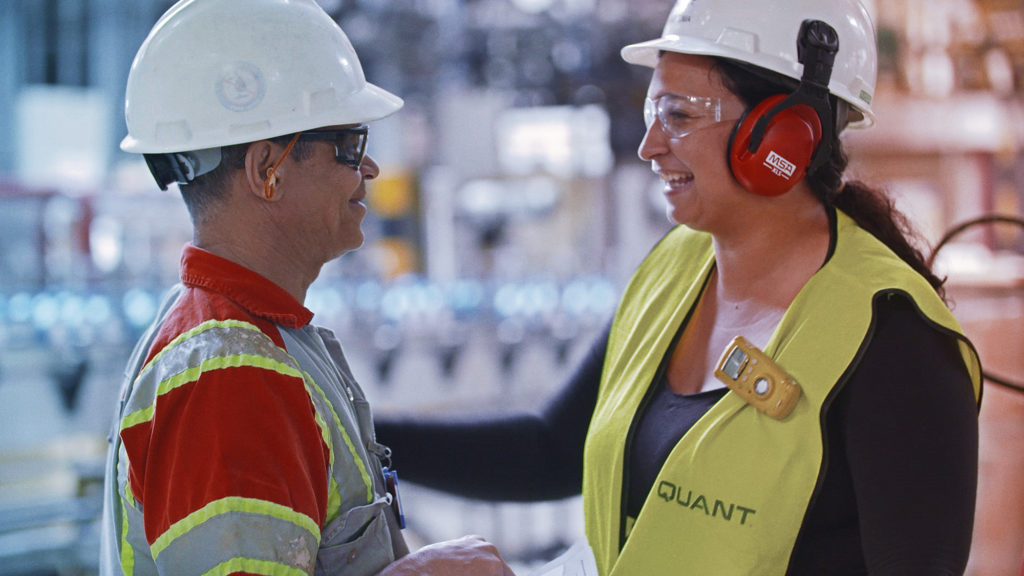novembro 4, 2020
Quant & Metsä Wood Punkaharju – Safety culture taken to a new level

Safety culture improvements are best seen in everyday situations. When in a hurry, or even an exceptional situation, we remember to stop at the right time and observe potential risk factors. Only then we can carry out the work safely.
All accidents can be prevented through risk assessment and good planning. Proactive safety measures are of great importance and these may include, for example, training or safety observations aimed at developing everyone’s own safety thinking.
Most importantly, the necessary measures must be taken on a regular basis and companies should encourage and provide support to their staff. A safe working environment requires co-operation, where everyone’s own choice is of great importance to the end-result achieved.
Understanding, commitment and courage
Improving safety culture requires action from every member of the team, from the installer to the management level. Understanding, commitment and courage is needed to take new steps in the development process.
Understanding and desire to contribute to the development of occupational safety. Commitment to finding safer ways to work and to take care of the safety of one’s co-workers. The courage to suspend work, or not to start, if risks are identified, and to report any deviation going forward.
Risk assessment plays a key role in ensuring the safe performance of a job. The fact that a person stops in the middle of a rush and goes through the instructions and possible hazards associated with a job is of great importance to the safety of the person performing the work, as well as others nearby.
Safety as a cornerstone of cooperation
When our cooperation with Metsä Wood in Finland started more than two and a half years ago, we were united by a strong will to develop the safety culture going forward. Metsä Wood had implemented development measures, but there was still a long way to go to reach the target level. The situation was challenging, and the promotion of an improved safety culture was identified as one of the most important areas for cooperation.
– Safety is our number one priority, and we are strongly committed to developing safety at every level of our company. Sure, there have been challenges along the way, but Quant’s way to develop safety has been great, says Mill Director Petri Mikkola, Metsä Wood Punkaharju.
– On the maintenance side, almost 1,100 accident-free days have already been reached, which is a great sign of the development of the safety culture.
– For both of us, safety is a strong value that takes companies forward. Everything starts with caring, and staff safety is always a priority, Mikkola adds.
Proactive and positive safety thinking
After the collaboration had started, the results began to show quickly on the maintenance side. The impact of proactive safety measures was emphasized by us, and risk assessments were always performed before starting to work. In addition, investments were made in safety training, and instructions and support were provided for the development of safety in the units. In particular, the importance of taking the necessary measures before starting to work was emphasized.
– Together, we have taken safety and Lockout-Tagout projects forward, among other things. The development of safety also includes steps that take time to implement, which means that the effects of all the measures taken are not yet visible, but we are constantly taking new steps towards a safer working environment, Mikkola says.
– There was a change in safety thinking and accidents started to decrease immediately with the new practices. The site has now achieved almost 1100 accident-free days, and 762 proactive safety measures have been taken in terms of safety observations and 638 risk assessments this year, says Quant’s site manager Janne Toivanen and supervisor Marko Malinen.
Safety is a team effort
Improving safety is a joint effort in a team, that strengthens team spirit and can only be achieved when working together as a team.
Proactive and positive safety thinking has now been developed with the customer for more than two years, and together we have reached a good level. However, maintaining and developing occupational safety requires constant work, meaning that the development does not end there.
– Safety development is specifically cooperation. The open conversation between us and Quant works well, which allows us to raise issues that require development openly in our discussions, Mikkola says.
– The partnership with Metsä Wood has been open and we have dared to discuss things very openly. This open partnership has also been of key importance in terms of safety development, says Quant Finland’s area director Mikko Luoma.
– There is still more to be done regarding safety, but it is also time to be satisfied and even a little proud of the achievements of the cooperation. Congratulations to Metsä Wood Punkaharju’s cooperation and staff for a wonderful achievement, Luoma adds.
Changes don’t happen in an instant, but the staff plays an important role as a key resource in safety. Employees from both companies have all the necessary tools to develop the safety culture even further; know-how, commitment and courage.

